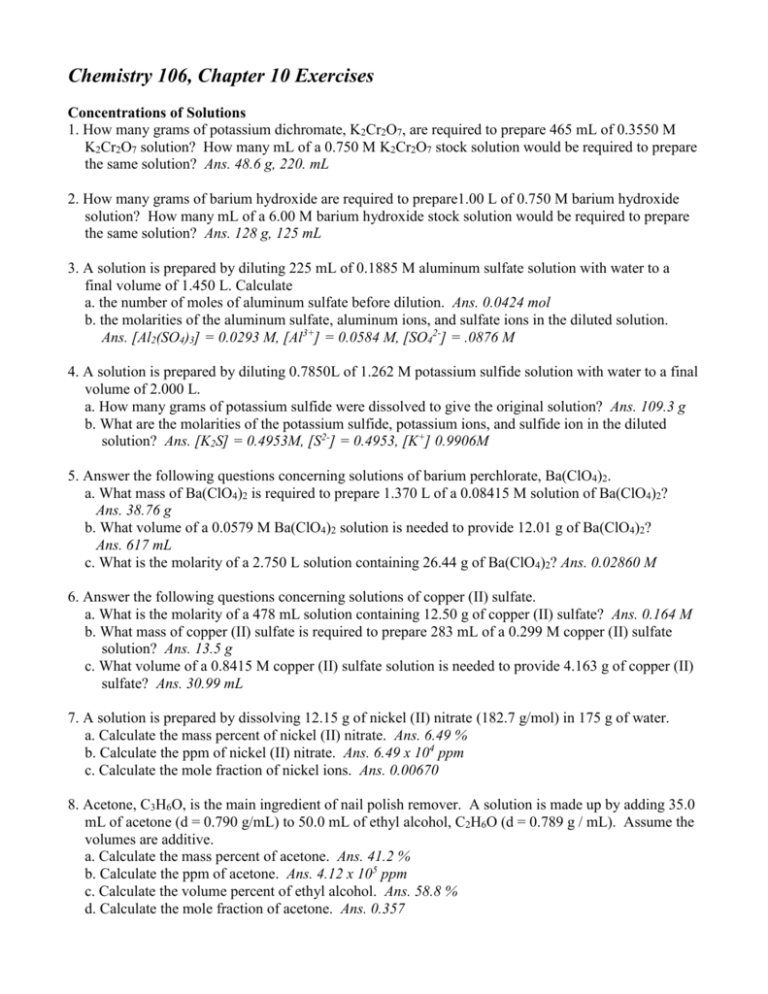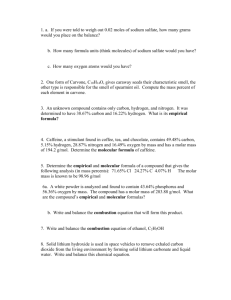Chapter 10, Solutions
advertisement

Chemistry 106, Chapter 10 Exercises Concentrations of Solutions 1. How many grams of potassium dichromate, K2Cr2O7, are required to prepare 465 mL of 0.3550 M K2Cr2O7 solution? How many mL of a 0.750 M K2Cr2O7 stock solution would be required to prepare the same solution? Ans. 48.6 g, 220. mL 2. How many grams of barium hydroxide are required to prepare1.00 L of 0.750 M barium hydroxide solution? How many mL of a 6.00 M barium hydroxide stock solution would be required to prepare the same solution? Ans. 128 g, 125 mL 3. A solution is prepared by diluting 225 mL of 0.1885 M aluminum sulfate solution with water to a final volume of 1.450 L. Calculate a. the number of moles of aluminum sulfate before dilution. Ans. 0.0424 mol b. the molarities of the aluminum sulfate, aluminum ions, and sulfate ions in the diluted solution. Ans. [Al2(SO4)3] = 0.0293 M, [Al3+] = 0.0584 M, [SO42-] = .0876 M 4. A solution is prepared by diluting 0.7850L of 1.262 M potassium sulfide solution with water to a final volume of 2.000 L. a. How many grams of potassium sulfide were dissolved to give the original solution? Ans. 109.3 g b. What are the molarities of the potassium sulfide, potassium ions, and sulfide ion in the diluted solution? Ans. [K2S] = 0.4953M, [S2-] = 0.4953, [K+] 0.9906M 5. Answer the following questions concerning solutions of barium perchlorate, Ba(ClO4)2. a. What mass of Ba(ClO4)2 is required to prepare 1.370 L of a 0.08415 M solution of Ba(ClO4)2? Ans. 38.76 g b. What volume of a 0.0579 M Ba(ClO4)2 solution is needed to provide 12.01 g of Ba(ClO4)2? Ans. 617 mL c. What is the molarity of a 2.750 L solution containing 26.44 g of Ba(ClO4)2? Ans. 0.02860 M 6. Answer the following questions concerning solutions of copper (II) sulfate. a. What is the molarity of a 478 mL solution containing 12.50 g of copper (II) sulfate? Ans. 0.164 M b. What mass of copper (II) sulfate is required to prepare 283 mL of a 0.299 M copper (II) sulfate solution? Ans. 13.5 g c. What volume of a 0.8415 M copper (II) sulfate solution is needed to provide 4.163 g of copper (II) sulfate? Ans. 30.99 mL 7. A solution is prepared by dissolving 12.15 g of nickel (II) nitrate (182.7 g/mol) in 175 g of water. a. Calculate the mass percent of nickel (II) nitrate. Ans. 6.49 % b. Calculate the ppm of nickel (II) nitrate. Ans. 6.49 x 104 ppm c. Calculate the mole fraction of nickel ions. Ans. 0.00670 8. Acetone, C3H6O, is the main ingredient of nail polish remover. A solution is made up by adding 35.0 mL of acetone (d = 0.790 g/mL) to 50.0 mL of ethyl alcohol, C2H6O (d = 0.789 g / mL). Assume the volumes are additive. a. Calculate the mass percent of acetone. Ans. 41.2 % b. Calculate the ppm of acetone. Ans. 4.12 x 105 ppm c. Calculate the volume percent of ethyl alcohol. Ans. 58.8 % d. Calculate the mole fraction of acetone. Ans. 0.357 9. Answer the following questions concerning solutions of potassium hydroxide. a. A 1.13 M solution of potassium hydroxide has a density of 1.05 g/mL. What is the molality and mass percent of the solute? Ans. 1.14 m, 6.04 % b. A 30.0 mass percent solution has a density of 1.29 g/mL. What is the molarity and the molality? Ans. 6.90 M, 7.64 m c. A 14.2 m solution has a density of 1.43 g/mL. What is the molarity and mass percent? Ans. 11.3 M, 44.4 % 10. Answer the following questions concerning solutions of ammonium sulfate. a. A 0.886 M solution of ammonium sulfate has a density of 1.06 g/mL. What is the molality and mass percent of the solute? Ans. 0.939 m, 11.0 % b. A 26.0 mass percent solution has a density of 1.15 g/mL. What is the molarity and the molality? Ans. 2.27 M, 2.66 m c. A 3.11 m solution has a density of 1.23 g/mL. What is the molarity and mass percent? Ans. 2.71 M, 29.1 % Predicting Solubilities (answers at the end of this section) 11. Which of the following is more likely to be soluble in benzene (C6H6)? a. CCl4 or NaCl b. hexane (C6H14) or glycerol (CH2OHCHOHCH2OH) c. acetic acid (CH3COOH) or heptanoic acid (C6H13COOH) 12. Which of the following is more soluble in CCl4? a. hexane (C6H14) or CaCl2 b. benzene (C6H6) or ethyl alcohol (C2H5OH) c. I2 or NaI 13. Choose the member of each set that would be more soluble in water? a. naphthalene (C10H8) or hydrogen peroxide H-O-O-H b. CaCO3 or NaOH c. methyl alcohol (CH3OH) or methyl ether (CH3-O-CH3) d. methane (CH4) or KI e. ammonia (NH3) or CH4 f. K2SO4 or CaSO4 Answers 11a. CCl4 b. hexane c. heptanoic acid 12a. hexane b. benzene c. I2 13a. H-O-O-H b. NaOH c. methyl alcohol d. KI e. ammonia f. K2SO4 Solubilities and Henry's Law 14. The Henry's law constant for the solubility of helium in water is 3.8 x 10-4 M/atm at 25oC. a. If the partial pressure of He at 25oC is 0.389 atm, what is the concentration of dissolved He in mol/L at 25oC? Ans. 1.5 x 10-4 M b. What volume of helium gas can be dissolved in 10.00L of water at 0.389 atm and 25oC. Ans. 95mL 15. The Henry's law constant for the solubility of argon in water is 1.0 x 10-3 M/atm at 30oC. a. If the partial pressure of Ar at 30oC is 0.912 atm, what is the concentration of dissolved Ar in M at 30oC? Ans. 9.1 x 10-4 M b. How many grams of argon gas can be dissolved in 25 L of water at 0.912 atm and 30oC? Ans. 0.91 g 16. A carbonated beverage is made by saturating water with CO2 at OoC and a pressure of 3.0 atm. The bottle is then opened at room temperature (25oC), and comes to equilibrium with air in a room where the PCO2 = 3.4 x 10-4 atm. The Henry's law constant for the solubility of CO2 in water is 0.0769 M/atm at OoC and 0.0313 M/atm at 25oC. a. What is the concentration of CO2 in the bottle before it is opened? Ans. 0.23 M b. What is the concentration of CO2 in the bottle after it is opened and is at equilibrium with the air? Ans. 1.1 x 10-5 M c. If the CO2 given off by 2 L of a carbonated beverage were collected and stored at 1 atm and 25oC what volume would it occupy? Ans. 11 L 17. The Henry's law constant for the solubility of oxygen in water is 3.30 x 10-4 M/atm at 12oC. Air is 21 mol% oxygen. How many grams of oxygen can be dissolved in one liter of a trout stream at 12oC (54oF) at an air pressure of 1.00 atm? Ans. 0.0022 g Colligative Properties 18. Using the equation ΔP1 = X2P1o, calculate the vapor pressure of water over each of the following ethylene glycol (C2H6O2) solutions at 22oC (vp of pure water = 19.83 mm Hg). For b and c, the mole fraction of ethylene glycol must be calculated first. a. XC2H6O2 = 0.288 Ans. vp = 14.1 mm Hg b. 39.0 mass % ethylene glycol Ans. XC2H6O2 = 0.157, vp = 16.7 mm Hg c. 2.42 m ethylene glycol Ans. XC2H6O2 = 0.0418, vp = 19.00 mm Hg 19. Calculate the osmotic pressure of the following solutions of urea, (NH2)2CO, at 22oC. a. 0.217 M urea Ans. 5.26 atm b. 25.0 g urea dissolved in 685 mL of solution. Ans. 14.7 atm 20. Calculate the freezing point and boiling point of each of the following solutions. (Kf = 1.86 oC/m Kb = 0.52 oC/m) a. 25.0 % by mass glycerin, C3H8O3 in water. Ans. Tf = -6.73 oC, Tb = 101.9 oC b. 28.0 g of propylene glycol, C3H8O2, in 325 mL of water (d = 1.00 g/mL). Ans. Tf = -2.10 oC, Tb = 100.59oC 21. Calculate the freezing and boiling points of 0.25 m aqueous solutions of the following: (Kf = 1.86 oC/m Kb = 0.52 oC/m) a. NH4NO3 b. NiCl3 c. Al2(SO4)3 Ans. a. Tf = -0.93 oC, Tb = 100.26 oC b. Tf = -1.9 oC, Tb = 100.52 o C c. Tf = -2.3, Tb= 100.65 oC 22. Arrange 0.30 m solutions of the following solutes in order of increasing freezing point and boiling point. Fe(NO3)3, C2H5OH, Ba(OH)2, CuSO4 Ans. F.P. Fe(NO3)3 < Ba(OH)2 < CuSO4 < C2H5OH B.P. C2H5OH < CuSO4 < Ba(OH)2 < Fe(NO3)3 Colligative Properties and Molar Mass 23. The Rast method uses camphor (C10H16O) as a solvent for determining the molar mass of a compound. When 2.50 g of cortisone acetate is dissolved in 50.00 g of camphor (Kf = 40.0oC/m), the freezing point of the mixture is 173.44oC. The freezing point of pure camphor is 178.40oC. What is the molar mass of cortisone acetate? Ans. 403 g/mol 24. An organic compound has an empirical formula of C3H2NO2. 3.16 g of this compound is dissolved in 75.0 mL of cyclohexane (d = 0.779 g/mL, Kf = 20.2oC/m). The solution has a freezing point of 0.0oC. The freezing point of pure cyclohexane is 6.50oC. What is the molar mass and molecular formula for the compound? Ans. 168 g/mol, C6H4N2O4 25. Lauryl alcohol is obtained from the coconut and is an ingredient in many hair shampoos. Its empirical formula is C12H26O. A solution of 5.00 g of lauryl alcohol in 100.0 g of benzene (Kb = 2.53oC/m) boils at 80.78oC. The boiling point for pure benzene is 80.10oC. What is the molar mass and molecular formula for lauryl alcohol? Ans. 186 g/mol C12H26O 26. A biochemist isolates a new protein and determines its molar mass by osmotic pressure measurements. A 50.0 mL solution is prepared by dissolving 225 mg of protein in water. The solution has an osmotic pressure of 4.18 mm Hg at 25 oC. What is the molar mass of the new protein? Ans. 2.00 x 104 g/mol 27. The molar mass of a type of hemoglobin was determined by osmotic pressure measurement. A student measured on osmotic pressure of 4.60 mm Hg for a solution at 20.oC containing 3.27 g of hemoglobin in 0.200 L of solution. What is the molar mass of the hemoglobin? Ans. 6.50 x 104 g/mol







